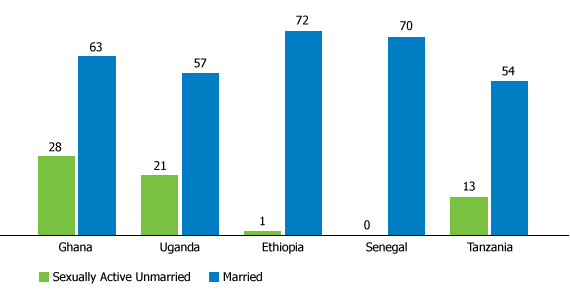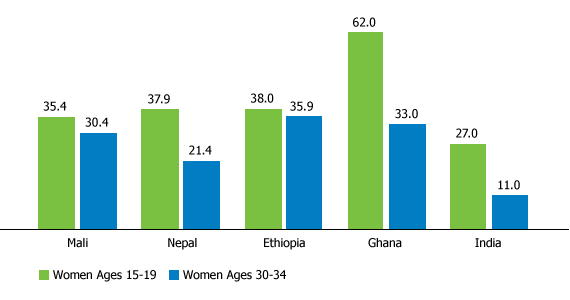
Are the 58 Million Girls Who Married Early Overlooked by Policies and Programs?
Date
August 8, 2011
Author
(August 2011) Despite the recent attention to ending early marriage around the world, married adolescents remain invisible to many policymakers and program developers.1 Unfortunately, this subpopulation tends to fall into a “no-man’s land” between existing initiatives, programs, and policies that deal with adolescent sexual and reproductive health, and maternal health services for married adult women. And while a recent data analysis by PRB reveals a slight but welcome decline in the number of girls getting married before age 15, they are still one of the largest and most vulnerable groups of adolescents in developing countries.
Given the substantial number of girls that have already been married around the world (58 million in the last decade), decisionmakers must invest in policies and programs that protect and support the health, economic, and social needs of these adolescents.2
Married adolescent girls tend to experience more health, economic, and social challenges and vulnerabilities than their unmarried counterparts and older married women. These risks not only threaten married girls’ reproductive health, but also their overall well-being.
Greater Reproductive Health Risks
Early marriage often brings greater risks to young girls’ sexual and reproductive health. Once married, they are more likely than their unmarried counterparts to engage in frequent sexual activity.3 In fact, data show that most sexual activity among adolescent girls takes place in the context of marriage (see Figure 1).
Figure 1
Sexual Experience Among Women Ages 15-19 (Percent)

Source: Karin Ringheim and Jay Gribble, Improving the Reproductive Health of Sub-Saharan Africa’s Youth: A Route to Achieve the Millennium Development Goals (Washington, DC: Population Reference Bureau, 2010).
Moreover, there is a dramatic rise in the frequency of unprotected sex among married adolescent girls. This phenomenon is driven by an intense pressure from their husbands, husband’s family, and communities to prove one’s fertility.4 In many developing countries, married adolescents have a much higher unmet need for contraception—meaning these young women want to delay, space, or limit their births and are not using contraception—than older married adult women (see Figure 2).
Figure 2
Unmet Need for Contraception Among Currently Married Women Ages 15-19 and 30-34 (Percent)

Source: Karin Ringheim and Jay Gribble, Improving the Reproductive Health of Sub-Saharan Africa’s Youth: A Route to Achieve the Millennium Development Goals (Washington, DC: Population Reference Bureau, 2010); and ICF Macro Demographic and Health Surveys 2005-2010.
Lack of information, fear of side effects, and other geographic, economic, and social barriers prevent married girls from obtaining and using family planning methods. The limited availability of family planning information and services puts them at risk for complications during pregnancy and delivery, obstetric fistula, or even death.5 Adolescent pregnancy is also associated with risks to the baby—such as preterm delivery, stillbirths, low birth weight, and newborn death. And young girls, who have no power to insist that older husbands use condoms, are at greater risk for sexually transmitted infections and HIV and AIDS.6
Lost Freedoms, Rights, and Opportunities
In most instances, married girls are isolated from their friends, families, and social networks. Married adolescents often miss out on health care services because of their age and lack of autonomy.7 They are also less likely to be in school, making it more difficult for them to realize their personal goals, find meaningful employment, and support their families and communities. Marriage also leads to a dramatic increase in girls’ workload, limiting their opportunities to participate in education and employment activities that might be available.8
Moreover, the low status of married adolescent girls within the household limits their negotiating power over when to have children, how and when to use contraception, and their ability to refuse sex. Although both married adolescents and married women are likely to experience domestic violence and coercive sex in many contexts around the world, married girls are less likely to find support to stop the abuse because of their social isolation.9
Why Are Investments in Married Girls Needed?
Investing in married adolescent girls contributes to the Millennium Development Goals through:
- Economic advancement. Married girls who earn a living can help eradicate poverty and hunger (MDG 1).
- Education. Married adolescent brides should be encouraged to complete primary and secondary education (MDG 2).
- Better health and empowerment. Empowering girls and young women to control their own fertility, seek treatment and health services when they need them, and make decisions about their own lives promotes gender equality (MDG 3).
- Fewer infant and child deaths. Delaying the first birth and spacing future pregnancies while improving access to antenatal, delivery, and postnatal care for young married adolescents significantly reduces infant and child deaths (MDG 4).
- Fewer maternal deaths. Adolescents face a much higher risk of dying during or after childbirth than older women (MDG 5).
- Reducing STIs/HIV. Providing married adolescents with the information and services they need to protect their reproductive health is a critical component of any program to reduce the prevalence of HIV (MDG 6).10
How Do Programs Support Married Adolescents?
Although there are few programs and policies to support married adolescents, some examples do exist. Each of the interventions uses a slightly different approach to reaching married girls, but they all emphasize providing girls with information and health services, building their sense of confidence and empowerment, and reducing their social isolation. For example, the Population Council’s First-Time Parents Project (2003-2008) worked with married adolescents in Gujarat and West Bengal, India, to improve their reproductive and sexual reproductive health. An important aspect of this project was that it worked with married women and their husbands through household visits, providing both with the reproductive health information and services needed to delay the first birth. Young married couples also received important information about birth spacing, safe delivery, postpartum care, and partner communication. At the same time, girls who were recently married, pregnant, and postpartum participated in a range of social and economic activities to build their self-esteem; these married adolescent girls were more likely to speak up for themselves when interactive with their husbands and within and outside of the family.11 More information is available in PRB’s list of additional programs that work with married adolescents.
By ignoring the economic, social, and health rights and needs of married adolescent girls, countries are failing to capitalize on the potential of all of their citizens. When married girls can take advantage of education and employment opportunities; improve their skills and social networks to participate in public life; and access comprehensive, accurate sexual and reproductive health information and services, they can make a healthy transition into adulthood and contribute to development efforts.
Alexandra Hervish is a policy analyst at the Population Reference Bureau.
References
- The World Health Organization defines “adolescents” as those between the ages of 10 and 19.
- Figure based on available data from developing countries, excluding China, from Demographic Health Surveys and Multiple Indicator Cluster Surveys between 2000 and 2010 in which women ages 20 to 24 reported being married by age 18.
- Peter McIntyre, Married Adolescents: No Place of Safety (Geneva: WHO, 2006); Rhonda Smith et al., Family Planning Save Lives (Washington, DC: Population Reference Bureau, 2009); and Judith Bruce and Shelley Clark, Including Married Adolescents in Adolescent Reproductive Health and HIV/AIDS Policy (Geneva: WHO, 2003).
- Bruce and Clark, Including Married Adolescents in Adolescent Reproductive Health and HIV/AIDS Policy.
- Smith et al., Family Planning Saves Lives.
- McIntyre, Married Adolescents.
- McIntyre, Married Adolescents.
- McIntyre, Married Adolescents; and Bruce and Clark, Including Married Adolescents in Adolescent Reproductive Health and HIV/AIDS Policy.
- Nicole Haberland, Erica L. Chong, and Hillary J. Bracket, A World Apart: The Disadvantage and Social Isolation of Married Adolescent Girls (New York: Population Council, 2004).
- Advocates for Youth, Youth’s Reproductive Health: Key to Achieving the Millennium Development Goals at the Country Level (Washington, DC: Advocates for Youth, 2005).
- K.G. Santhya et al., Empowering Married Young Women and Improving Their Sexual and Reproductive Health: Effects of the First-time Parents Project (New Delhi: Population Council, 2008), accessed at www.popcouncil.org/pdfs/India_FirstTimeParents.pdf, on July 22, 2011.
